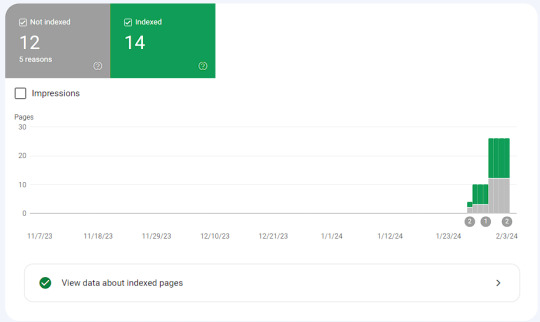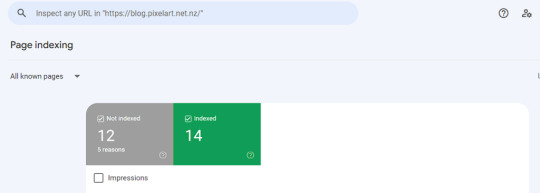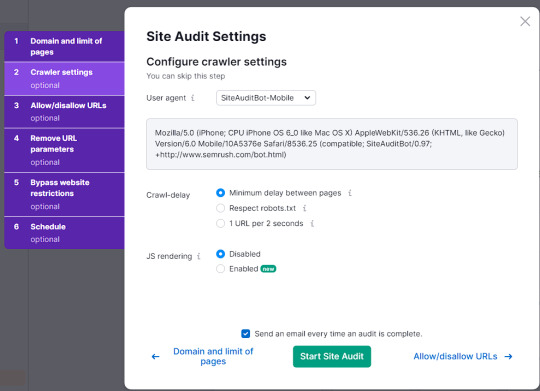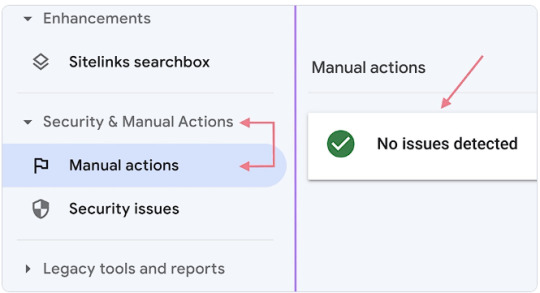#seo checklist
Text
What tools do you use to improve website rankings?
Boosting your website rankings requires a multifaceted approach.
Here's a lineup of indispensable tools that can help you climb the search engine ladder.
1. Keyword Research Tools
The Foundation of SEO
Keyword research tools are your gateway to understanding what your target audience is searching for. They provide insights into relevant keywords, their search volume, and competition. SEO Audit Tools include SEMrush, Ahrefs, and Google Keyword Planner.
2. On-Page SEO Tools
Crafting SEO-Optimized Content
To optimize individual pages for search engines, on-page SEO tools are indispensable. They analyze your content for factors like keyword usage, meta tags, headers, and readability. Yoast SEO and Moz On-Page Grader are valuable choices.
3. Backlink Analysis Tools
Building Authority
Building a robust backlink profile is crucial for SEO success. Tools like Moz's Link Explorer and Ahrefs allow you to analyze your backlinks, identify toxic links, and explore opportunities for link building.
4. Technical SEO Tools
Technical SEO tools help uncover and rectify issues that might hinder your website's performance. They check for issues like site speed, mobile-friendliness, and XML sitemaps. Google's PageSpeed Insights and Screaming Frog SEO Spider are top picks.
5. Content Management Systems (CMS)
Choosing the right CMS, such as WordPress or Joomla, can simplify content management and SEO efforts. These platforms often offer plugins and extensions to enhance SEO capabilities.
Conclusion
In the quest to improve your website rankings, these tools are your trusted allies. From understanding your audience through keyword research to optimizing your content with on-page SEO tools and building authority with backlinks, the right tools can make the journey smoother and more effective.
Remember, achieving and maintaining high website rankings is an ongoing endeavor, so embrace these tools, adapt your strategies, and keep climbing the search engine ladder. Your digital success story awaits.
FAQs about Tools for Improving Website Rankings
Q1: Can I rely solely on tools to improve my website rankings?
While tools are invaluable, a successful SEO strategy should encompass content creation, user experience optimization, and link building in addition to tool usage.
Q2: Are there free alternatives to paid SEO tools?
Yes, many free SEO tools offer essential features, although paid tools often provide more comprehensive data and advanced functionalities.
Q3: How often should I perform keyword research?
Keyword research is an ongoing process. Aim to revisit your keyword strategy periodically, especially when targeting new topics or industries.
Q4: Is it necessary to hire an SEO expert or agency?
Depending on your resources and expertise, you can either manage SEO in-house or hire experts. An experienced SEO professional or agency can provide valuable insights and save you time.
3 notes
·
View notes
Text
How to Perform a Complete SEO Audit
How to Perform a Complete SEO Audit
Conducting an SEO audit involves assessing the optimization level of your website for search engines. This evaluation highlights any issues that might hinder your site’s ranking and also uncovers potential areas for improvement, enhancing your chances of achieving greater online visibility. An SEO audit usually covers areas like:
Indexing and crawlability
User experience
Site architecture
Competitor benchmarking
Keyword research
On-page SEO
Backlink profile
It is basically an overall “health check” for a website. A successful SEO website audit relies on concrete data pertaining to the technical condition, traffic, and backlink portfolio of your website, as well as those of your competitors.
How to Do An SEO Audit
1. Check for Indexing Issues


Keep in mind that not all pages need to undergo indexing—only those you intend to rank in search results. It is entirely normal to have certain URLs that remain unindexed. Here are examples of URLs that are not required to be indexed:
Pages with redirects
Admin pages
Alternate pages with canonical tags
Feed pages



2. Check for Duplicate Versions of Your Site
It is crucial to ensure that Google is indexing only a single version of your website. Your site may exist on various URL versions, depending on factors such as the presence of “WWW” in the domain and the use of HTTPS. From a search engine perspective, these variations are distinct versions of the site:
http://www.yoursite.com
http://yoursite.com
https://www.yoursite.com
https://yoursite.com
Running your website on multiple URL versions can lead to complications in crawling, indexing, and ranking, primarily because Google considers them as duplicates. Furthermore, maintaining several site versions can dilute PageRank, negatively impacting your SEO rankings. You can easily check this by entering all versions of your site into a web browser. You should be automatically redirected to the preferred version. For instance, if your preferred URL version is https://yoursite.com, entering any other version into your browser should redirect you to it.
If you can access your site through various versions, use a 301 redirect for the other versions.
3. Run a Site Crawl
A good SEO audit is crawl-based.

4. Check for Manual Actions
If your site violates Google’s spam policies, it may receive a manual action from Google. A manual action means that your site’s rankings will drop until Google revokes the action. This can either be at the page level or sitewide. Some reasons why you may have received a manual action include:
Keyword stuffing
Unnatural links (both to and from your site)
Various kinds of spam
Thin content with little or no added value

If there’s a manual action against your website, you need to fix the issues and make a reconsideration request. Check Google’s Manual Actions guide for more details.
5. Check for Mobile-Friendliness Issues
We reside in a mobile-centric era, and if your website lacks mobile-friendliness, chances are you’re not prioritizing user experience. Mobile-friendliness stands out as a primary Page Experience signal for Google. In fact, it has been a ranking factor since 2015, directly impacting your potential to rank in search results. To identify any issues related to mobile usability, you can refer to the Mobile Usability report in Google Search Console. Just click “Mobile Usability” under the “Experience” section in the left menu.
6. Analyze Your Site’s Speed
Now, more than ever, the speed at which your site loads is of utmost importance. Page speed has held its position as a ranking factor for an extended period, contributing to higher Google rankings.
Additionally, it serves as a critical element in user experience. Analyzing user behaviors reveals that as a page’s loading time increases, the likelihood of a user leaving the website also rises.
7. Analyze Your Core Web Vitals
In 2020, Google introduced��three new metrics related to page speed and user experience:
Largest Contentful Paint (LCP): measures how long it takes to load the largest piece of the page
First Input Delay (FID): measures the delay between the user’s first interaction with a page and the browser’s response to it
Cumulative Layout Shift (CLS): measures how much the layout of the page shifts for the user, as well as visual stability

Since Core Web Vitals are a ranking factor, checking these metrics for your key pages should definitely be part of your SEO site audit. Google Search Console comes to the rescue here again. Head to the “Core Web Vitals” report under the “Experience” section in the left menu. You’ll see both “Desktop” and “Mobile” reports listing all the issues and the affected pages.
These reports offer comprehensive insights into any Core Web Vitals issues your site might encounter. The tool differentiates between pages with severe problems (termed as “poor URLs”) and those that require minor enhancements. Review the identified issues and adhere to the provided instructions for resolution. For a dedicated Core Web Vitals report, simply access the “Core Web Vitals” widget on the dashboard in Site Audit.
8. Analyze Your Internal Links
Internal links play a pivotal role in SEO for three key reasons:
They facilitate search engine crawling of your website.
They assist users in navigating your website.
They enable you to channel link equity, also known as “authority” or “link juice,” towards the most critical pages.
9. Check Your Organic Traffic

There are four main metrics in the report.

10. Benchmark Against Your Competitors
A good SEO audit should also help you see where you stand when compared to your competitors. A great way to start is to use Domain Overview. The tool will give you a solid comparison of the key metrics of the selected domains. These will give you a good overview of where you’re lagging behind or excelling.
To get the best overview, focus on these metrics:
Authority Score: the overall quality of the domain on a scale from 1 to 100 (based on backlinks, search traffic, and other factors)
Organic Traffic: how much organic traffic the domain receives
Organic Keywords: shows how many keywords the domain ranks for
Referring Domains: shows how many different domains link to the analyzed domain (This provides a better picture for comparison than the overall number of backlinks.)
11. Find Keywords You’re Missing Out On
Conducting an SEO audit presents an excellent chance to examine the keywords targeted by your competitors and determine if there are any opportunities you might be overlooking.
12. Audit and Improve Your Top Pages
While a general site crawl is effective in identifying technical issues throughout your website, it’s equally beneficial to closely examine specific pages, especially those of utmost importance. Analyzing their performance and seeking ways for improvement constitutes an on-page SEO audit.
To streamline this process, the On Page SEO Checklist proves invaluable. Set up the project, input your pages, and specify their target keywords. The tool offers the flexibility to either automatically identify pages and keywords or manually input them.
0 notes
Text
Latest Trends with Trending Khazana
Dive into the world of trends and discoveries with Trending Khazana! Explore the latest and most exciting trends in fashion, lifestyle, technology, and more. From insightful articles to captivating visuals, Trending Khazana is your go-to destination for staying ahead of the curve. Join us on a journey of discovery and innovation!
1 note
·
View note
Text
Mastering the Digital Realm: Your Ultimate SEO Checklist for 2024!

It is almost 2024, and if your website isn’t dominating the search engine game, it’s time to step up your SEO. This ain’t your grandpa’s SEO anymore. We’re talking AI, mobile-first everything, and content that’s fire. So take your seat and let’s dive into the ultimate SEO checklist for the year.
For more information visit our Blog: https://www.seowebplanet.com/mastering-the-digital-realm-your-ultimate-seo-checklist-for-2024/
0 notes
Text

Unlock SEO Success with This Comprehensive Checklist! 🚀 Dive into Keyword Research, Master On-Page Optimization, Tackle Technical SEO, and Elevate Your Site with Strategic Link Building. Your Roadmap to Search Engine Domination starts here!
Contact Codearoma Technologies for digital marketing services in Ahmedabad.
#seo checklist#seo services#seo company#search engine optimization#digital marketing#digital marketing agency#digital marketing company#codearoma technologies
1 note
·
View note
Text
Affordable SEO Tactics for Small Businesses: Paving the Way to Triumph
Are you looking to build a website or improve your existing one? Well, let me tell you about the importance of responsive design in web development and Google ranking.
First of all, let’s define responsive design. It’s a design approach that ensures a website looks and works well on any device, whether it’s a desktop, laptop, tablet, or smartphone. With so many people accessing the internet from various devices, having a responsive design is essential to provide them with a seamless and consistent experience.
Not only does responsive design enhance user experience, but it also impacts Google ranking. In 2015, Google announced that mobile-friendly websites would receive a boost in search rankings. This means that websites that are not optimized for mobile devices will not rank as high in search results as those that are.
Moreover, Google’s mobile-first indexing approach means that it primarily uses the mobile version of a website’s content to index and rank pages. This makes it even more crucial to have a responsive design that ensures your website looks and performs well on mobile devices.
So, what are the benefits of having a responsive design in addition to better Google ranking? First, it ensures that your website is accessible to a wider audience, regardless of their device. It also enhances user experience, making it more likely for visitors to stay on your website, engage with your content, and even convert into customers.
In today’s fast-paced digital world, having a website with a responsive design is no longer an option, but a necessity. It ensures your website is user-friendly, accessible, and optimized for search engines, resulting in better visibility, traffic, and engagement.
Ad Digital markeing service
0 notes
Text
Your 7-Step SEO Content Checklist for Better Search Rankings
In the world of online search, getting your website to appear on the first page is like striking gold. Achieving higher search engine rankings is crucial for businesses and website owners to be found by their target audience. This is where Search Engine Optimization (SEO) comes into play. A well-structured SEO content checklist is your roadmap to higher rankings and increased visibility on search engines like Bing. Let's simplify the process with a user-friendly, 7-step guide to boost your site's search rankings.
Start with Smart Keyword Research
Keywords are the compass of your SEO journey. Begin by understanding what words and phrases your potential audience is typing into search engines. Tools like Google Keyword Planner or Bing Keyword Research can help you identify high-value keywords relevant to your content.
Craft High-Quality, Valuable Content
Content is at the heart of SEO. Your content should not only use those keywords naturally but also provide real value to your readers. High-quality, informative, and engaging content is more likely to rank well on search engines.
Optimize Meta Tags
Meta tags, specifically the meta title and meta description, are the first things users see in search results. Make them attention-grabbing and relevant by including your target keywords.
Structure Content with Headers
Headers (H1, H2, etc.) break up your content and make it easier for both readers and search engines to understand the structure. Use headers to organize your content logically.
Build Links Effectively
Links play a critical role in SEO. Internal links guide users to other relevant pages on your site, while external links to authoritative sources show that your content is well-researched and trustworthy.
Optimize Images and Ensure Mobile Responsiveness
Images enhance content, but they should be optimized for faster loading times. Use descriptive file names and alt text for images. Additionally, ensure your website is mobile-responsive. Search engines favor mobile-friendly sites, especially as more users browse the web on their smartphones.
Prioritize Page Loading Speed and User Experience
A fast-loading website not only improves the user experience but also positively affects SEO. Compress images, minimize scripts, and leverage browser caching to speed up your site. Focus on creating a user-friendly experience with easy navigation and clear calls to action.
Remember that SEO is an ongoing effort. Regularly update your content to signal to search engines that your website is active and relevant. Stay informed about the latest SEO trends and algorithm updates, as the search landscape is constantly evolving.
By following this 7-step SEO content checklist, you'll be well on your way to improving your search engine rankings. It's a user-friendly and effective approach that can help your website shine on search engines like Bing and connect with your target audience more successfully.
#SEO Checklist#Search Engine Optimization#SEO Tips#Keyword Research#Content Optimization#Meta Tags#SEO Best Practices#Content Quality
1 note
·
View note
Text
The Art of Storytelling in Marketing: Engaging Your Audience with Narratives
The Art of Storytelling in Marketing: Engaging Your Audience with Narratives with Digital Orix, the Premier SEO Company in Jaipur
In the dynamic world of digital marketing, the ability to captivate and engage your audience is paramount. One powerful tool that has stood the test of time is storytelling. As the Premier SEO Company in Jaipur, Digital Orix has been a leading force in helping businesses enhance their online visibility and generate more sales since 2018. In this blog, we’ll explore the art of storytelling in marketing and how it can help you connect with your audience on a deeper level.

The Power of Storytelling in Marketing
Storytelling is more than just conveying information; it’s about creating a compelling narrative that resonates with your audience. When done right, storytelling can:
Forge Emotional Connections: Stories evoke emotions, helping your audience connect with your brand on a personal level.
Enhance Brand Identity: A well-crafted narrative can define your brand’s identity, values, and mission, making it more relatable.
Improve Engagement: Engaging stories grab your audience’s attention and keep them invested in your message.
Boost Memorability: People remember stories far better than facts or statistics, making your brand more memorable.
Digital Orix’s Expertise in Storytelling
As the Premier SEO Company in Jaipur, Digital Orix understands the importance of storytelling in marketing:
Content Creation: Our skilled content creators craft compelling stories that align with your brand’s message and resonate with your target audience.
SEO Optimization: We infuse storytelling into your website’s content, optimizing it for search engines to improve your online visibility.
Visual Storytelling: We leverage visual content, such as videos and graphics, to tell your brand’s story in a captivating way.
Brand Story Development: We help you define and develop your brand’s unique narrative, ensuring it aligns with your business goals.
The Elements of Effective Brand Storytelling
Identify Your Audience: Understand your target audience’s preferences, needs, and pain points to craft a story that resonates with them.
Craft a Compelling Narrative: Develop a clear and engaging storyline that highlights your brand’s values, mission, or products.
Create Relatable Characters: Whether it’s your brand’s founder, employees, or satisfied customers, relatable characters can add authenticity to your story.
Showcase Real-Life Experiences: Share authentic, real-life experiences that demonstrate how your brand solves problems or makes a positive impact.
Visual Appeal: Incorporate visual elements that enhance your narrative, such as images, videos, and infographics.
Consistency: Ensure that your storytelling aligns with your brand’s identity and messaging across all marketing channels.
Conclusion
Storytelling is a timeless art that can elevate your marketing efforts to new heights. As the Premier SEO Company in Jaipur, Digital Orix is your trusted partner in crafting compelling narratives that engage your audience and enhance your brand’s online visibility. Don’t underestimate the power of storytelling in conveying your message, building emotional connections, and boosting your overall marketing success. Contact us today, and let us help you master the art of storytelling to create a lasting impact on your audience.
0 notes
Text
2 notes
·
View notes
Text

Proven Strategies To Boost Your Website’s SEO With Minimal Efforts
While it may sound like a daunting task, there are several strategies that can significantly improve your website’s SEO with minimal efforts like these:
1. Optimize for Local SEO If your business has a physical location, optimize for local search by including location-specific keywords and creating a Google My Business profile. At Future Insights, the best SEO company in Bangalore, we focus on optimizing businesses for Local SEO before aiming for a global reach. And I can attest to the efficiency of this strategy.
2. Regularly Update Content Fresh, up-to-date content signals to search engines that your website is active and relevant. Update existing content and publish new articles regularly.
3. Utilize Google Analytics and Search Console These tools provide valuable insights into your website’s performance, including which keywords are driving traffic and how users interact with your site. By implementing these strategies, you can significantly boost your website’s SEO with minimal effort.
Remember, SEO is an ongoing process, so continue to monitor your website’s performance and make adjustments as needed. With dedication and consistency, you’ll see your website climb the ranks in search engine results.
0 notes
Text
#website audit#on page checklist#Off page seo checklist#seo checklist#technical seo checklist#UXUI#technology#blogger
0 notes
Text
On-Page SEO Checklist: Boost Your Brand’s Online Visibility
Today, we offer a comprehensive on-page SEO checklist, encompassing crucial elements for all brands. Implementing these tactics will amplify website performance, bolster search engine visibility, and drive increased traffic, elevating your brand's value. Take a moment to prepare for a successful on-page strategy propelling your brand to...Read More

0 notes
Text
The Ultimate SEO Checklist: Boost Your Website's Ranking

Introduction
In the realm of enhancing your website's visibility and driving organic traffic, Search Engine Optimization (SEO) emerges as a pivotal player. Embracing a comprehensive SEO Checklist equips you with the tools to optimize your website for search engines, thereby elevating your prospects of securing a higher rank in search results.
Embarking on your journey, the following elements stand as indispensable facets to bolster your website's SEO prowess
Keyword Research and Analysis:
The foundational step involves identifying pertinent keywords and phrases germane to your content and industry. Employing proficient keyword research tools facilitates the evaluation of search volume, competition, and relevance.
On-Page SEO checklist
A harmonious melody of elements harmonizes to form effective on-page SEO. Begin with the optimization of your title tag, ingeniously weaving in the primary keyword. Subsequently, craft a captivating meta description designed to beckon clicks from the search results. The rhythmic application of heading tags (H1, H2, H3) orchestrates a logical structure within your content.
High-Quality Content
The cornerstone of your SEO journey is the creation of content that is not only original but brimming with information and engagement. Striking a balance in content length is imperative, upholding its relevance while satiating your audience's thirst for knowledge.
Mobile-Friendly Design
Your website's appeal extends to its responsiveness across diverse devices. Ensuring an impeccable display across various screens is crucial.
Page Speed Optimization
The tempo of your website's performance is fine-tuned through meticulous page speed optimization. Streamline by reducing unnecessary elements to curtail HTTP requests. Elevate user experience by enabling browser caching, bestowing faster load times upon returning visitors.
Technical SEO Checklist
Within the realm of SEO, the technical aspect forms a vital symphony. Craft a meticulous Technical SEO Checklist - an XML sitemap lays the groundwork for search engine exploration. Elevate content with schema markup, enhancing search results.
User Experience (UX) and Site Architecture
A harmonious symphony of user experience and site architecture beckons. Navigate through the maze of website structure, ensuring logical arrangement and easy exploration. The user-centric design sings through a seamless interface and resonating calls-to-action.
Backlink Strategy
The melody of SEO ascends through a well-orchestrated backlink strategy. Cultivate a garden of high-quality, relevant backlinks to grace your digital landscape. Seek the spotlight through guest postings on authoritative platforms, enhancing your resonance in the digital orchestra.
Social Signals
Amplify your reach by imparting a social cadence to your content. Converse with your audience across social media platforms, unveiling your content's allure and fanning the flames of engagement. Enrich your composition with social sharing buttons, inviting the audience to partake in the symphony.
Regular Monitoring and Analysis
As the curtains rise and the performance unfolds, vigilance becomes your guiding baton. Observe the metrics through tools like Google Analytics and Search Console. Translate data into insights, discerning the nuances of organic traffic, click-through rates, and conversion rates.
Conclusion
Enveloped within this comprehensive SEO Checklist symphony, your website is poised to ascend the ranks and bask in the limelight of search results. The crescendo of your efforts, orchestrated by the SEO Checklist, will be the enchanting melody of a higher website ranking and an audience captivated by your virtuoso performance.
0 notes